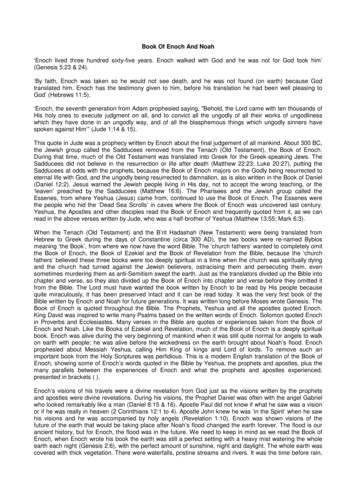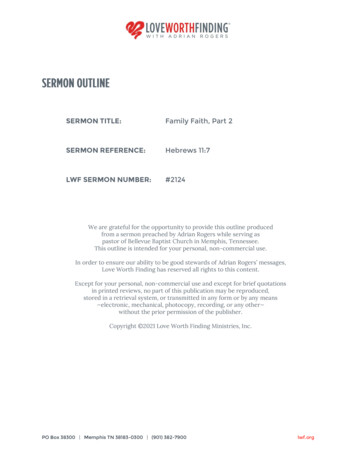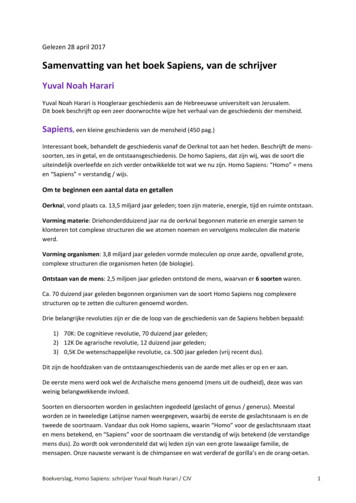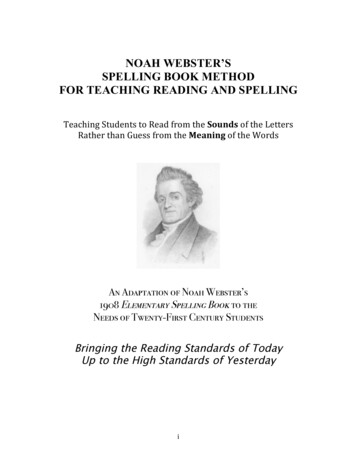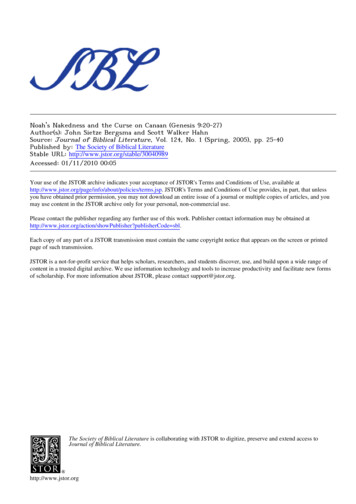
Transcription
Noah's Nakedness and the Curse on Canaan (Genesis 9:20-27)Author(s): John Sietze Bergsma and Scott Walker HahnSource: Journal of Biblical Literature, Vol. 124, No. 1 (Spring, 2005), pp. 25-40Published by: The Society of Biblical LiteratureStable URL: http://www.jstor.org/stable/30040989Accessed: 01/11/2010 00:05Your use of the JSTOR archive indicates your acceptance of JSTOR's Terms and Conditions of Use, available rms.jsp. JSTOR's Terms and Conditions of Use provides, in part, that unlessyou have obtained prior permission, you may not download an entire issue of a journal or multiple copies of articles, and youmay use content in the JSTOR archive only for your personal, non-commercial use.Please contact the publisher regarding any further use of this work. Publisher contact information may be obtained herCode sbl.Each copy of any part of a JSTOR transmission must contain the same copyright notice that appears on the screen or printedpage of such transmission.JSTOR is a not-for-profit service that helps scholars, researchers, and students discover, use, and build upon a wide range ofcontent in a trusted digital archive. We use information technology and tools to increase productivity and facilitate new formsof scholarship. For more information about JSTOR, please contact support@jstor.org.The Society of Biblical Literature is collaborating with JSTOR to digitize, preserve and extend access toJournal of Biblical Literature.http://www.jstor.org
JBL 124/1 (2005) 25-40NOAH'S NAKEDNESSAND THE CURSE ON CANAAN(GENESIS 9:20-27)JOHN SIETZE f Steubenville,Steubenville,OH43952SCOTT of Steubenville,Steubenville,OH 43952The compressed, elusive narrativeof Gen 9:20-27 has been an exegeticalpuzzle since antiquity.1The terseness of the account, with its inexplicable features and subtle hints of sexual transgression, has left generations of readersand scholars feeling that there is more to the story than the narratorhas madeexplicit. As many have pointed out, interpretive debates generally revolvearound two interrelated questions: (1) the nature of Ham'soffense (why wouldHam's "seeing" Noah's nakedness merit a curse?), and (2) the rationale forCanaan'spunishment (if Ham was the perpetrator,why was Canaancursed?).2The basic outlines of the story (Gen 9:20-27) are well known. After theflood, Noah plants a vineyard,drinksof its wine, becomes drunk, and uncovershimself in a tent (v. 21). Ham, identified as the father of Canaan, "sees the1 For a review of rabbinic and some patristic exegesis of the passage, see Albert I. Baumgarten, "Mythand Midrash:Genesis 9:20-29," in Christianity,Judaism, and Other Greco-RomanCults: Studiesfor Morton Smith at Sixty (ed. Jacob Neusner et al.; 4 vols.; Leiden: Brill, 1975),3:55-71. Susan Niditch calls the text "intriguingand difficult"(Chaos to Cosmos:Studies in BiblicalPatterns of Creation [Atlanta:Scholars Press, 1985], 51), while Marc Vervenne characterizesit as"an eccentric anecdote of which the reception and interpretation are often equally fantastic"("What Shall We Do with the Drunken Sailor? A Critical Re-Examination of Genesis 9.20-27,"JSOT 68 [1995]: 55).2 See Donald J. Wold, Out of Order: Homosexualityin the Bible and the Ancient Near East(Grand Rapids:Baker, 1998), 66; Devorah Steinmetz, "Vineyard,Farm, and Garden:The Drunkenness of Noah in the Context of PrimevalHistory,"JBL113 (1994): 198.25
26Journal of Biblical Literaturenakedness of his father" (m1 t m'sT'51)and tells his brothers outside (v. 22).Shem and Japheth take a garment and enter the tent backwards. With eyesaverted, they cover their father (v. 23). When Noah awakens,he realizes whatHam had "done to him" (i1 ;ot, v. 29). He then blesses Shem and Japheth,butcurses Ham'syoungest son, Canaan (w. 25-27).Exegetes since antiquityhave identified Ham's deed as either voyeurism,castration, or paternal incest. This last explanation seems to be enjoying arevival of popularity in some recent scholarship. This article will argue for afourth possible explanationof Ham's deed: maternal incest, which simultaneously explains the gravityof Ham's offense and the rationale for the cursing ofCanaan,who is the fruit of the illicit union. The full case for this view has neverbeen adequately presented, and it is particularlyapropos to do so now, giventhe increasing interest in the theory of paternalincest.3In what follows we will first review the traditionalexplanationsfor Ham'soffense, identifying their weaknesses. Then, building on the work of other narrative critics, we will demonstrate the exegetical basis and explanatorypower ofthe theory of maternal incest.4 In particular,we will show that the argumentsfor the currently popular interpretation of Ham's deed as paternal incest aremore suited to support maternalincest.I. The TraditionalViewsVoyeurismThe view that Ham's offense was voyeurism-that he did nothing morethan behold his naked father-has enjoyed widespread support both in antiq-3 F. W. Bassett first proposed the maternal-incestinterpretationin a brief (five-page) article,without, unfortunately, marshaling all the arguments in favor of it ("Noah's Nakedness and theCurse of Canaan:A Case of Incest?"VT 21 [1971]: 232-37). Isaac M. Kikawadaand ArthurQuinnendorse the theory in passing, adding some new ideas (BeforeAbraham Was: The Unity of Genesis1-11 [Nashville:Abingdon, 1985], 101-3). For proponents of the theory of paternal incest, see nn.12-13 below.4 A brief word on methodology. We find ourselves most closely aligned with the narrativeanalysis of Robert Alter, who discerned that literary intentionality often lies behind apparentinconcinnities in the narrativeof Genesis (The Art of Biblical Narrative [New York:Basic Books,1981]). We are also instructed by Michael Fishbane's demonstration of the exegetical value ofattentiveness to the complex and, at times, reciprocalinterrelationshipsamong biblical texts (Biblical Interpretation in Ancient Israel [New York:Oxford University Press, 1984]). Guided by thework of these scholars and other exegetes, we make a heuristic "inferenceto the best explanation."We wish to show that the theory of maternalincest best explainsthe otherwise anomalousfeaturesof both the text and its relationshipto its context.
Bergsmaand Hahn: Noah's Nakedness27uity and in modernity.5 The strength of this position is its conservatism: itrefuses to see anythingin the text that is not explicit. Yet, in a sense, voyeurismis a nonexplanation,since it fails to elucidate either the gravityof Ham'soffenseor the reason for the curse of Canaan.It also requires the interpreter to assumethe existence of a taboo against the accidental sight of a naked parent that isotherwise unattested in biblical or ancient Near Eastern literature. Donald J.Wold remarks,"Scholarswho accept the literal view. must defend a customabout which we know nothing."6Some proponents of this view are content to accept the awkwardfeaturesof the narrative of Gen 9:20-27 as inexplicable and/or arbitrary.7However,those exegetes who, through the work of Robert Alter, Michael Fishbane, andothers, have come to appreciate the literaryartistryand subtlety of the biblicalauthors and the significance of biblical intertextualityare unlikely to find thisposition satisfactory.8There is increasingrecognition that the pentateuchal narrative is seldom careless or arbitrary,and intertextual echoes (to be examinedbelow) are seldom coincidental.9CastrationThe traditionalrabbinicview that Ham castratedNoah arose as an attemptto address the inadequacies of the voyeuristicinterpretation.10A classic discussion of the view is found in b. Sanh. 70a:5 E.g., H. Hirsch Cohen, The Drunkenness of Noah (Judaic Studies 4; University,AL: University of Alabama Press, 1974), 14-16; Allen P. Ross "The Curse of Canaan,"BSac 130 (1980):223-40; Victor P. Hamilton, The Book of Genesis Chapters 1-17 (NICOT; Grand Rapids: Eerdmans, 1990), 322-23; Gordon P. Wenham, Genesis 1-15 (WBC 1; Waco: Word, 1987), 198-201;Joseph Blenkinsopp, The Pentateuch (ABRL;New York:Doubleday, 1992), 87; Umberto Cassuto,A Commentary on the Book of Genesis (trans. I. Abrahams;2 vols.; Jerusalem: Magnes, 1964),2:149-54; E. A. Speiser, Genesis: Introduction, Translation, and Notes (AB 1; Garden City, NY:Doubleday, 1964), 61; Kenneth A. Matthews,Genesis 1-11:26 (NAC; Nashville:Broadman& Holman, 1996), 418-20; Claus Westermann, Genesis 1-11: A Commentary(trans.John J. Scullion, S.J.;Minneapolis:Augsburg, 1984), 484-88.6 Wold, Out of Order, 67.7 E.g., Speiser, Genesis, 62.s See n. 4 above.9 For example, concerning the pericope under discussion, Vervenne concludes: "the tale ofthe drunken Noah . has been meticulously embedded in a genealogical framework. . . This precisely embedded composition . is also a self-contained piece of art"("WhatShallWe Do with theDrunken Sailor?"43-44).10For an extensive review of the rabbinicexegesis of this passage, see Baumgarten,who concludes that the rabbis developed the theory of castrationas an explanationfor features of the text("Mythand Midrash,"55-71); thus, they are not transmittingan ancient tradition (contra RobertGraves and Raphael Patai, Hebrew Myths: The Book of Genesis [Garden City, NY: Doubleday,1966], 121-22). The relevant rabbinictexts are b. Sanh. 70a; Gen. Rab. 36, 7; Tanh.49-50; Pirqe R.
28Journal of Biblical LiteratureAnd Noah awoke from his wine, and knew what his younger son had doneunto him. [With respect to the last verse] Rab and Samuel [differ,] one maintaining that he castrated him, whilst the other says that he sexually abusedhim. He who maintainsthat he castratedhim, [reasonsthus:] Since he cursedhim by his fourth son, he must have injured him with respect to a fourth son.But he who says that he sexuallyabused him, drawsan analogybetween "andhe saw"written twice. Here it is written, And Ham the father of Canaan sawthe nakedness of his father; whilst elsewhere it is written, And whenShechem the son of Hamor saw her [he took her and lay with her and defiledher]. Now, on the view that he emasculated him, it is right that he cursed himby his fourth son; but on the view that he abused him, why did he curse hisfourth son; he should have cursed him himself?-Both indignities were perpetrated. (Soncino translation)Here we see the sages grappling with the two issues of the text identified above:the gravity of Ham's sin and the cursing of Canaan. Rab concludes that Hammust have castrated Noah. In favor of Rab's view, one can cite examples fromancient Near Eastern mythology (although none from the Bible) of a son castrating his father as part of an effort to usurp his authority.11 Thus, Rab's viewsuggests a possible motivation for Ham's crime. It also provides some rationale,albeit complex, for the cursing of Canaan: Noah curses Ham's fourth son sinceHam deprived Noah of a fourth son. What is lacking, however, is any lexicalhint in the text of Gen 9:20-27 that would suggest castration.Paternal IncestSamuel's alternative view-that Ham sexually abused Noah-is enjoying asurprising contemporary resurgence, gaining the support of a number of scholars who represent divergent theological and methodological approaches butare united by conviction that the literary artist of Genesis conveys somethingmore in Gen 9:20-27 than a simple "voyeurist" reading of the passage reveals.One of the more thorough defenses of this position is by Robert Gagnon in hisrecently published The Bible and Homosexual Practice, but other proponentsinclude Anthony Phillips, Devorah Steinmetz, Martti Nissinen, Donald J.Wold, Seth Daniel Kunin, and O. Palmer Robertson.12 In addition, RobertEl. ch. 23; Tg. Ps.-J.on Gen 9:24-25. The earliest reference to this theory is found in Theophilus ofAntioch, Ad Autolycum 3, 19.11See Graves and Patai, Hebrew Myths, 122.12 Robert A. J. Gagnon, The Bible and Homosexual Practice: Texts and Hermeneutics(Nashville: Abingdon, 2001), 63-71; Anthony Phillips, "Uncovering the Father's Skirt,"in hisEssays on Biblical Law (JSOTSup344; Sheffield: Sheffield Academic Press, 2002), 245-50; Steinmetz, "Vineyard,"193-207; Martti Nissinen, Homoeroticism in the Biblical World (Minneapolis:Fortress, 1998), 53; Wold, Out of Order, 65-76; Seth Daniel Kunin, The Logic of Incest: A Structuralist Analysis of Hebrew Mythology (JSOTSup185; Sheffield: Sheffield Academic Press, 1995),
Bergsma and Hahn: Noah's Nakedness29W. E. Forrest, Ellen van Wolde, and Susan Niditch are sympathetic,if not committed, to the view.13As Hermann Gunkel, Gagnon, and many others have pointed out, the way') tothe text describes Noah as realizing"whathis youngest son had done (1ibnThim" suggests some action more substantialthan passive viewing.14It suggestsan act or deed of which Noah was the recipient or victim. Indeed, it so happensthat the phrase used to describe Ham'stransgression-"to see the nakedness ofthe father"(: r nrn nr)-is an idiom for sexual intercourse.15Leviticus 20:17equates the idioms "to see nakedness"(,D rl,-1) and "to uncover nakedness"If a man takes his sister . . . and sees her nakedness, and she sees his nakedness, it is a disgrace, . he has uncovered his sister's nakedness.16The phrase "to uncover nakedness"(mnnsnb), in turn, is the usual expressionfor sexual intercourse in the Holiness Code:. n'n; nnfabl'aprnM nTJ " D"-2-b m's 7'MNone of you shall approach anyone near of kin to uncover nakedness. (Lev18:6)The same idiom (,nm n)) occurs in descriptionsof sexualpromiscuityand sexual violence in Ezek 16:36-37; 22:10; 23:10, 18, 29. Thus, from an intertextualperspective, the description of Ham's act as "seeing his father's nakedness"implies more than a literal "seeing."7173-74; 0. Palmer Robertson, "CurrentCritical Questions Concerning the 'Curse of Ham' (Gen.9:20-27),"JETS 41 (1998): 179.13Robert W. E. Forrest, "ParadiseLost Again:Violence and Obedience in the Flood Narrative,"JSOT 62 (1994): 15-16; Ellen van Wolde, Stories of the Beginning: Genesis 1-11 and OtherCreation Stories (Harrisburg,PA: Morehouse, 1997), 146; Niditch, Chaos, 52-53. If we have readthese authorscorrectly,they appear to lean toward the paternal-incestview.14Hermann Gunkel remarks,"Thiscannot be all, because v. 24 presumes that Canaan [sic]had done something to him" (quoted in Westermann, Genesis, 488). Gagnon notes that "'whathisyoungest son had done to him' [is] not the expression one would expect to describe an unintendedglance or even voyeurism" (Homosexual Practice, 65). See also Wold, Out of Order, 73; andRobertson, "Curseof Ham," 179.'1 See Kunin, Logic, 174; Gagnon, Homosexual Practice, 66; Hans-Jiirgen Zobel, "gald,"TDOT 2:479; Steinmetz, "Vineyard,"198: "clearlythe 'seeing of nakedness' implies a sexual violation, as it does throughout the biblical text"; Robertson, "Curse of Ham," 179; and Vervenne,"WhatShall We Do with the Drunken Sailor?"49: "the key-wordhere, mu' . . does have an eroticand sexual connotation."16Unless otherwise noted, all English biblical quotations are from the NRSV.17See Steinmetz, "Vineyard,"199.
30Journal of Biblical LiteratureBesides the use of the phrase "to see nakedness" (nmnlnw), there areother eroticallycharged lexemes in Gen 9:20-27 that suggest a situationof sexual transgression.Wine (p'), for example, is intimatelyconnected with sexualityin both biblical and ancient Near Eastern literature.s8 Significantly,the onlyother reference to drunkennessin Genesis also occurs in the context of parentchild incest: Gen 19:30-38, the account of Lot'sintercourse with his daughtersas the origin of Moab and Ammon. The Song of Songs is replete with images ofwine as a symbol of sexualityand-strikingly-the vineyard (nc:) as a place oflovemaking.19The drinking of wine functions as a prelude to intercourse inSong of Songs (8:2) and in the dealings of David with Uriah the Hittite (2 Sam11). Uriah refuses to go home, where he would "drinkand lie with [his] wife"(2 Sam 11:11), so David gets him drunkin the hopes that he will dispense withhis scruples and return to enjoy his spouse (2 Sam 11:13). Other biblical examples of the associationof wine with sex could be cited, and the extensive ancientNear Eastern evidence (e.g., the cult of Dionysus/Bacchus and its analogues)has been explored elsewhere.20In addition to the vineyard (oD )and wine (p]), there is the word used forNoah's disrobing or "uncoveringhimself," bn', from the root nt. This root isused extensively in Leviticus 18 and 20 and variouspassages of Ezekiel, often incombination with n'1n, to designate illicit (usually incestuous) sexual intercourse, and also in the two verses of Deuteronomy that condemn parent-childincest (Deut 23:1 and 27:20).21 Usually Noah's disrobing is thought to bemerely the result of his drunkenness, yet individuals typically do not disrobesimply because they are drunk. Noah's "uncovering himself' in the tent certainly carries erotic overtones.22Steinmetz comments, "Justas 'seeing' nakedness is more than seeing, 'uncovering'is more than uncovering."23When Gen 9:20-27 is understood as a case of parent-child incest, literarylinks with other pericopes in Genesis and the rest of the Pentateuch suddenlybecome apparent. For example, several narrative critics have suggested thatGen 9:20-27 is chiasticallylinked to Gen 6:1-4, the story of the intercourse ofthe "sons of God" with the "daughters of men."24One story introduces the18For an explorationof the associationof wine and sexualityin ancient Greek, Egyptian, andHebrew literature, see Cohen, Drunkenness,3-6.19See Song 1:2, 4, 6; 2:13, 15; 5:1; 6:11; 7:2, 9, 12; 8:2, 11-12.20See literaturecited by Cohen, Drunkenness,3-6.21See Steinmetz, "Vineyard,"199: "To 'uncover'nakedness is the other term which the Bibleuses to describe sexual immorality";and Zobel, TDOT 2:479.22Cohen, Drunkenness, 17.23Steinmetz, "Vineyard,"199.24 See Kikawadaand Quinn, Before Abraham Was, 101-3; Wold, Out of Order, 70; and thecomments of Forrest: "Ham's actions may justly be associated with the activities of the 'sons ofGod' in 6.1-4 who similarlybroke ranks . . Ham's 'offense', with its implicationsof incest, echoes
Bergsmaand Hahn: Noah's Nakedness31flood narrative,and the other concludes it; Gen 5:32 continues in Gen 9:28-29,forming an inclusio around the two stories.25When Gen 9:22 is understood aspaternalincest, it becomes clear that the two stories are united by the theme ofillicit sexual intercourse as well.Likewise, Niditch, Steinmetz, Kunin, and many others see thematic linksbetween Gen 9:20-27 and Gen 19:30-38, the story of Lot's daughters and theprocreationof Moab and Ammon.26The similaritiesbetween the two pericopesare numerous: in the aftermath of a calamitous divine judgment, instigated bythe wickedness of men-particularly sexual wickedness (cf. Gen 6:4; 19:5),which destroys the earth or a large part of it-an aged patriarch gets drunk,facilitatingintercourse between parent and child, giving rise to one or more ofthe traditionalenemies of Israel (Canaan, Moab, and Ammon).27The parallelshardly seem coincidental. Steinmetz points out that "the parallel between theLot story and the vineyardstory supportsthe implicationof a sexualviolation ofNoah by his son."28More than one scholarhas noted a relationshipbetween Gen 9:20-27 andLeviticus 18 and 20.29 Leviticus 18 and 20 are integrally linked in that ch. 20specifies the penalties for sins described in ch. 18. Both chapters are linked toGen 9:20-27 by the words and phrases "to uncover" (nk), "nakednessof thefather" (:r nn), and "to see nakedness" (rnn Trlm).Moreover, Leviticus 18opens with a warning not to imitate the practices of the inhabitantsof Canaanor Egypt, the two most prominent descendants of Ham (v. 3, cf. Gen 10:6).30Several commentators have seen the introduction to Leviticus 18 (vv. 1-5) asreferring to Ham's violation of Noah, arguing either chs. 18 and 20 are a legalreflection on Gen 9:20-27 or that Gen 9:20-27 is an etiological narrativebasedthe account of the illicit activities of the sons of God and the daughtersof men ('dm)which precipitated the flood. . . . Thus the Ham incident provides a fitting conclusion to the [Flood Narrative]with its resounding echoes of both ch. 3 and the opening pericope of 6.1-4" ("Paradise Lost,"15-16).25See Vervenne, "WhatShall We Do with the Drunken Sailor?"43: "Gen. 9.28-29 virtuallyconcludes 5.32."26Calum M. Carmichaelnotes, "Thetwo earliest incidents of incestuous conduct in the bookof Genesis involve drunkenness,first Noah's and then Lot's. The two incidents have much in common: the role of wine, the initiativetowardthe parent from the son or daughter . . . the concern forfuture generations" (Law, Legend, and Incest in the Bible: Leviticus 18-20 [Ithaca, NY: CornellUniversity Press, 1997], 15). See also Gagnon, Homosexual Practice, 70; and Steinmetz, "Vineyard,"199 n. 13.2' For a thorough examinationof the similaritiesof the passages, see Niditch, Chaos, 53-55.28Steinmetz, "Vineyard,"199.29E.g., Wold, Out of Order, 66; Phillips, Essays on Biblical Law, 247-48; Steinmetz, "Vineyard,"198-99.30See Steinmetz, "Vineyard,"198-99, esp. n. 12; Pss 105:23, 27; 106:22;78:51.
Journal of Biblical Literature32on Lev 18:1-8.31 Seen in this light, it then becomes significant that the very firstsexual transgression Leviticus 18 lists in association with the Hamitic nationsCanaan and Egypt is parental incest, literally,"uncoveringyour father'snakedness" (nn .t . . "]7' nn', w. 7-8), essentially the crime Ham committed("T3 nnt' n . On t ). This would make good sense if the author/redactorof Leviticus 18 interpreted Ham's deed in Gen 9:20-27 as a sexual violation ofNoah, setting a precedent of incestuous sexual relations for his descendants.A similar situation exists with respect to Deut 23:1:A man shall not take his father's wife, and shall not uncover his father's skirt.[ASV]Phillips argues:Deuteronomy 23: b is a deliberate enactment of the Deuteronomist and ispart of his anti-Canaanite material. It was added at the head of the list of prohibited sexual relations in Lev 18.7-23 which the Canaanites, the formerinhabitants of the land, were held to have committed (Lev 18.24-30) becauseno relationship was more abhorrent to the Israelites than that associated withHam, the father of Canaan.3"2Phillips regards Ham's sin in Gen 9:20-27 as paternal incest and argues thatDeut 23:1b should be understood literally,as referringto sexual relations withone's father.33In addition to clarifyingthe links between Gen 9:20-27 and other relatedpentateuchal texts, proponents of the paternal-incesttheory point out that theirview offers a possible motivation for Ham's deed. By humiliating his father,Ham hoped to usurp his father'sauthorityand displace his older brothers in the31 For example, Vervenne feels that both texts are Priestly and that the author teaches byillustrationin 9:20-27 what is conveyed by law in Leviticus 18 and 20: "In Gen. 9.20-27, the rulesand regulationsto which Israel adheres . are projected onto the screen of primevaltimes" ("WhatShall We Do with the Drunken Sailor?"52-53). Ross remarks,"The constant references to 'nakedness' and 'uncovering'and even 'seeing' in this passage [Lev 18:2-6] . . . clearly remind the readerof the action of Ham, the father of Canaan.No Israelite . could read the story. without makingthe connection" ("Curseof Canaan,"233-34). Gordon Wenham comments, "Lev 18:3 links bothEgypt and Canaan as peoples whose habits are abominable . Ham's indiscretion towards hisfather may easily be seen as a type of the later behavior of the Egyptians and Canaanites"(Genesis1-15, 201). See also Carmichael,Law, 14-44, and Cassuto, Commentaryon the Book of Genesis,149-50.32Phillips, "Uncoveringthe Father's Skirt,"250.33Ibid., 245-50. Phillips'smain argument is that if "uncoveringthe skirt"means the same as"taketo wife," then Deut 23:la and 23:1b are tautologous. However, "uncoveringthe skirt"is notexactlythe same as "takingto wife";the former refers to sexual relations, the latter to marriage.
Bergsma and Hahn: Noah's Nakedness33familial hierarchy.34Nissinen notes that the story "does not speak of Ham'shomosexual orientation but his hunger for power."35This explains why Hampromptly informed his brothers of what he had done (Gen 9:22b).An obvious objection to the paternal-incest view is that the brothers'action in v. 23 indicates that Noah's nakedness was literal;thus Ham's "seeing"in v. 22 should be taken literally (as voyeurism) rather than idiomatically (asintercourse). But the objection is not conclusive. Gagnon comments on the significance of v. 23:andtakinggreatThe brothers'actionsin "coveringtheirfather'snakedness"of "seepainsnot to lookat theirfatheris compatiblewithan interpretationing another'snakedness"as sexualintercourse.Thebrothers'actionsplay onthe broader meaning of the phrase. Not only did the brothers not "see theirfather'snakedness"in the senseof havingintercoursewithhim,but alsotheyin a literalsense.Wheredid not even dareto "seetheirfather'snakedness"Ham'sact was exceedinglyevil, their gesturewas exceedinglypious andnoble.36Likewise, Steinmetz, while acknowledging that v. 23 "support[s]the idea thatsexual violation has broader implications than whatever physical act may beinvolved,"nonetheless does not feel that Shem and Japheth'saction "negatesthe implication of sexual immoralityin this story."37To summarize, the interpretationof Ham's deed as paternal incest is supported by the idiomatic meaning of the phrase "to see the nakedness of thefather" (3r nnsl ren) and erotic undertones of the text. It has the heuristicvalue of clarifying and illuminating intertextual relationships between Gen9:20-27 and Gen 6:1-4; 19:30-38; Lev 18; 20; and Deut 23:1. It also provides apossible explanation for Ham's motivation. However, it does not address therationalefor the cursing of Canaan.38The arguments scholars have marshaled in favor of the paternal-incesttheory are substantive.The erotic imageryof the text, the idiomatic meaning of"to see nakedness,"the parallelswith other pentateuchal texts, and the nature34 E.g., Nissinen (Homoeroticism, 53), and Gagnon, who claims, "By raping his father andalerting his brothers to the act, Ham hoped to usurp the authorityof his father and elder brothers,establishinghis right to succeed his father as patriarch"(HomosexualPractice, 66-67).35Nissinen, Homoeroticism,53.36Gagnon, HomosexualPractice, 67 (emphasis ours). Wold (Out of Order, 74) and Robertson ("Curseof Ham," 180) argue similarly.37Steinmetz, "Vineyard,"200 n. 15.3"Paternal-incestinterpreters like Wold (Out of Order, 75-76) and Gagnon (HomosexualPractice, 67) claim that their theory elucidates why Canaan rather than Ham is cursed, but in factthey must resort to diachronic (historical-critical)explanationsnot necessarily tied to the paternalincest hypothesis. In other words, they tacitly concede that paternal incest does not make sense ofthe cursing of Canaanwithin the logic of the narrative itself.
Journal of Biblical Literature34of Ham'sdeed as a familial-politicalpower play all seem to supportthe supposition that Ham committed an incestuous act. To maintainin the face of this evidence that Ham merely looked at Noah is to turn a deaf ear to the literarynuances of the narrative.In what follows, however, it will be demonstrated thatin almost every instance, these arguments for paternal incest are better suitedto argue for maternalincest.II. The Maternal-IncestViewWe begin with the idiomatic meaning of the phrase "rZnll'Frn, "to seethe father'snakedness"(v. 22). Proponents of the theory of paternal incest arecorrect to equate imnl Fr fwith mnl nb , "to uncover nakedness" via Lev20:17, understanding both as euphemisms for sexual intercourse. However,one may take this valid insight one step furtherby recognizingthat in all the relevant texts, m,1? ,tn/ I is associated with heterosexual activity, and "thenakedness of the father"(3 nin) actually refers to the mother'snakedness.39For example, in Lev 18:7-8, the "nakednessof your father"is defined as "thenakedness of your mother":ntnym!T 7rm P r rn8 nrr n-pn n Q nlL17Youshallnot uncoverthe nakednessof yourfather,whichis the nakednessof yourmother;she is your mother,you shallnot uncoverher nakedness.sYoushallnotuncoverthe nakednessof yourfather'swife;it is the nakednessof yourfather.Likewise, Lev 18:14, 16; 20:11, 30, 21 all describe a woman'snakedness as thenakedness of her husband. The same logic is at work in Deut 23:1 and 27:20,which describe intercourse with one's father'swife as "uncoveringthe father'sskirt"(r:' 7r nb).On the contrary,the two verses in the Pentateuch that condemn homosexual relations (Lev 18:22 and 20:13) use the verb "Do,not m ,a/n% as in Gen9:21-23. No combinationof the terms nn, nW',and/or7ba is found associatedwith homosexual relations anywhere in the Bible.Therefore, the phrase 13t nnfl , fl in Gen 9:22 is a euphemism for sexual39 See Gagnon, Homosexual Practice, 69 n. 72: "The prohibition against intercourse with'your father, which is the nakedness of your mother; she is your mother' refers to intercourse withone's mother, not one's father."Besides its use in Leviticus 18 and 20, the phrase occurs only inEzek 22:10, where Ezekiel is quoting a list of sins from the Holiness Code (see ibid., 66 n. 67).Thus, outside of Genesis 9, the phrase "nakednessof the father"(3 nn) in the Bible alwaysrefersto the nakedness of the father'swife.
Bergsmaand Hahn: Noah's Nakedness35intercourse indeed, but heterosexual ratherthan homosexualintercourse. If wetake full account of the nuance of the biblical idiom, the statement that Ham"saw his father's nakedness" implies relations with Noah's wife, presumablyHam's mother. This is supported by the fact that the imagery of the vineyard(Dr) and wine (v") is asso
Curse of Canaan: A Case of Incest?" VT 21 [1971]: 232-37). Isaac M. Kikawada and Arthur Quinn endorse the theory in passing, adding some new ideas (Before Abraham Was: The Unity of Genesis 1-11 [Nashville: Abingdon, 1985], 101-3). For proponents of the theory of paternal incest, see nn. 12-13 below. 4 A brief word on methodology.



